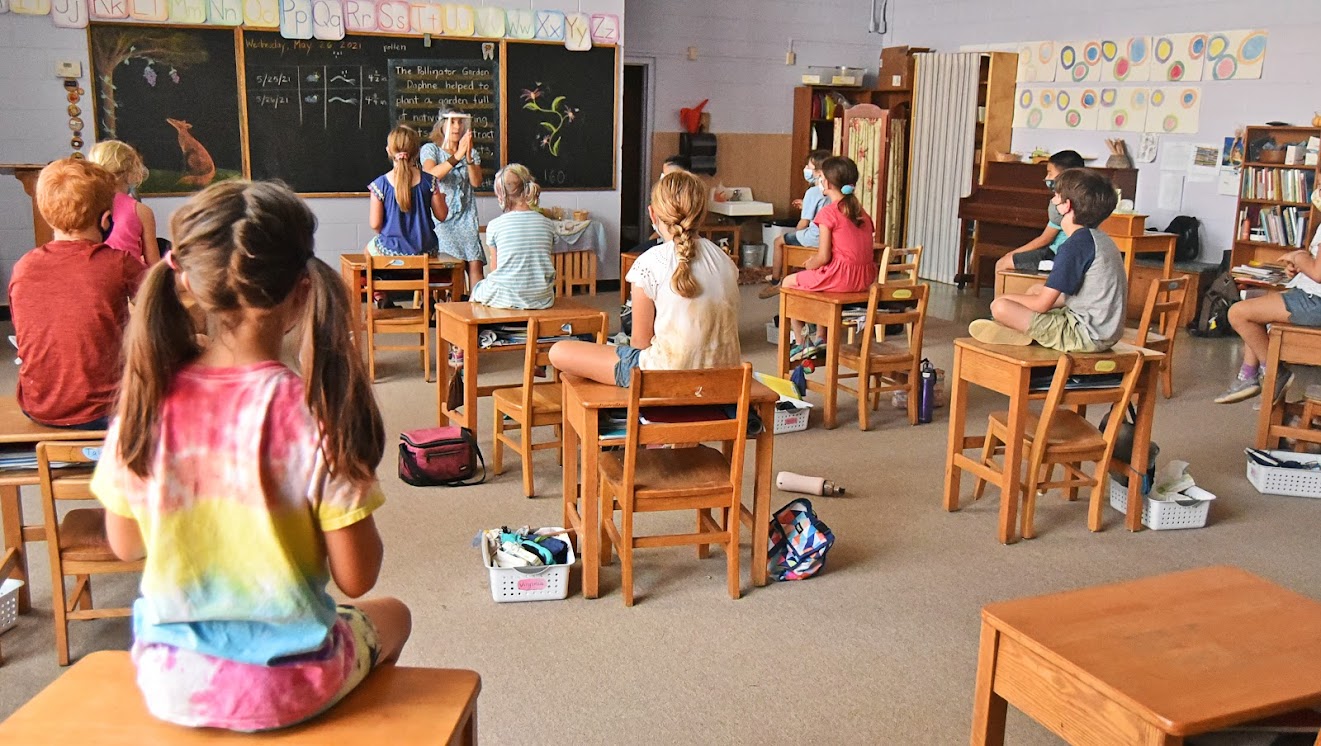Studies Support Waldorf Education’s Approach to Reading

Written by Holly Korbey, July 28, 2020 via Edutopia
Early in the school year at John Ruhrah Elementary and Middle School, co-teachers Darene Parry and Megan Healy were already diving deep into a lesson about the human heart, showing their fourth graders detailed anatomical diagrams and introducing vocabulary like cardio and circulatory.
Surprisingly, the unit on “having a good heart”—rich in scientific dialogue and writing practice—is not part of science class, but English language arts (ELA).
“Students see the connections between what we are learning in ELA and other subjects,” said Parry of the interdisciplinary curriculum at their school in Baltimore, Maryland, where classes often cover similar topics through different lenses and where the majority of students are English language learners. “They frequently bring up background knowledge that they’ve learned in other classes, and I don’t think they question why we are also learning these topics in ELA.”
Parry, Healy, and their fellow Baltimore City Public Schools teachers are part of a growing group of educators who have shifted away from the traditional ELA reading curriculum, which tends to expose students to unfamiliar subjects and teaches skills like “finding the main idea” and “summarizing.” According to the Baltimore district and other school systems, this skills-based approach to reading instruction has done little to improve reading proficiency for many students and ignores growing research that emphasizes the crucial role of background knowledge in comprehending what you read.
“Students with more [background] knowledge have a better chance of understanding whatever text they encounter,” said Natalie Wexler, an education journalist and author of The Knowledge Gap, who spent two years closely watching how elementary schools were teaching reading. “They’re able to retrieve more information about the topic from long-term memory, leaving more space in working memory for comprehension. They’re also better able to absorb and retain information, because knowledge—like Velcro—sticks best to other related knowledge.”
LEVELING THE PLAYING FIELD
Three years ago, a group of Baltimore City school leaders set out with an ambitious task: find a new reading curriculum for the district to improve students’ reading comprehension skills.
The city’s reading scores had been declining for a decade, and by 2017, they trailed far behind those of most other urban districts, as reflected by the National Assessment of Educational Progress (NAEP) reading test that found only 13 percent of fourth and eighth graders reading at a proficient level. Like those of other large urban districts, Baltimore City’s reading scores were also distributed unevenly along racial and socioeconomic lines, with low-income students and students of color scoring more than 20 points below their wealthier, whiter peers.
Diving into cognitive science research on reading comprehension, the group determined that background knowledge about other subjects—like social studies, science, and the arts—played a much bigger part in reading comprehension than the literacy skills they had emphasized for years.
The landmark baseball study from Donna Recht and Lauren Leslie, for example, found that struggling readers who knew a lot about baseball did better on a reading comprehension test about it than strong readers who knew nothing about the sport. And in another study, high schoolers who met a basic knowledge threshold on a dense topic like ecosystems had much stronger performance on a reading test about ecosystems than those who didn’t. For low-income students and students of color, these disparities were particularly pronounced.
“I think there’s enough research now that shows that [just teaching] reading strategies is not conducive to [helping students] read challenging text independently,” said Heidi Foley, John Ruhrah’s literacy coach.
Now, students in Baltimore learn typical ELA skills like comprehension, figurative language, and sight reading by grounding them in concepts they’ve already covered in their social studies and science classes. While simultaneously studying the U.S. colonial era in social studies, for example, students may read anchor text about the American Revolution, hold a Socratic seminar on the beginnings of the war, and then write an essay defending one side’s position using the vocabulary they learned in ELA.
HOW DOES THE BRAIN MAKE SENSE OF WHAT IT READS?
Yet some educators aren’t aware of the cognitive science on reading comprehension—and the crucial role of privilege and background knowledge—and continue to administer tests and assignments that may inadvertently skew student performance, argues journalist Natalie Wexler, along with many cognitive science researchers. With access to greater resources, a child from a middle- or upper-class family is more likely to be taken on trips, attend events, or be exposed to experiences that deepen their cultural and social knowledge base. These experiences give them a foundation to process and understand difficult reading passages—context that peers from less-resourced families can lack.
“Reading tests are really knowledge tests in disguise,” says Daniel Willingham, a cognitive psychologist at the University of Virginia and author of the book The Reading Mind: A Cognitive Approach to Understanding How the Mind Reads.
Willingham says the brain uses three processes to understand a complex text: extracting ideas from individual sentences; stringing together sentences and the concepts they convey to build sequential meaning; and finally, forming an overarching, deeper understanding of the text. While strong oral language skills—like having a highly-developed understanding of syntax and usage—can take a reader pretty far in comprehension, when readers are introduced to longer, more complicated texts, they need more information about the topic to help them comprehend meaning.
Background knowledge, both about the topic and about the world in general, plays an important role in helping students make sense of a text because the things readers already know work like a scaffold on which to build a more complete—and nuanced—mental model of the subject matter. Readers without background knowledge start without any scaffold in place, in other words, and the new information they are asked to process has nothing to hang on.
A QUESTION OF CURRICULUM
In order to teach the kind of knowledge-rich lessons that will improve students’ reading comprehension, Willingham says, teachers should emphasize a cohesive, well-sequenced curriculum with lots of background information on different topics embedded within it so that no students are left hanging when they read.
While the research on curricula like Baltimore’s Wit and Wisdom and others like it is still emerging, early results indicate promise. Long-term pilot studies of E.D. Hirsch’s Core Knowledge curriculum (based on the work of professor and literary critic E.D. Hirsch), used in some Denver and New York City schools, show large gains for students’ ELA skills. And a small study involving the new Bookworms curriculum showed significant improvements in students’ comprehension skills over schools that used a more traditional reading curriculum.
Like Baltimore City Public Schools, more districts are also starting to embrace the cognitive science of reading and taking a bold step—upending the ELA methods they’d used for years.
In Louisiana, that’s meant the adoption of a brand-new curriculum designed by state educators and guided by research that has boosted elementary reading scores by seven points over the last few years.
“We have backed away from reading skills and strategies,” said Dana Talley, who helped implement the curriculum in the northern half of the state. Though teachers struggled at first, Talley said giving them time to understand the new way of teaching and the space to improve their skills has paid off. “Now when I say the word ‘skills’ in front of the ELA people, they give me dirty looks.”
Louisiana schools are also determined to find out whether their investment in background knowledge will pay off. Before the coronavirus outbreak, the state began piloting ELA assessments based on the actual content students are learning, instead of the standard state tests that claim to measure more general skills.
At Richmond Waldorf School, we recognize that our student’s physical, social and emotional well-being are a key part of their ability to learn and thrive. Our holistic approach to education prioritizes critical thinking, communication, collaboration and creativity to prepare students for the challenges of the 21st century.
We are accepting applications for the 2022-2023 school year. Join an information session or meet with our Enrollment Administrator to learn more about Richmond Waldorf School.
Choosing a school is a very important decision in a family’s life. Our admissions process is designed to give you as much information as you need to make an informed decision about enrolling your children. Whenever possible, we encourage all families to book a visit when considering Richmond Waldorf School. We want to meet you! It is just as important for us to know who you are and what you are looking for in a school, as it is for you to know who we are and what Waldorf education is about.
Valerie Hogan
Enrollment & Marketing Administrator
| 804-377-8024 ext 3
